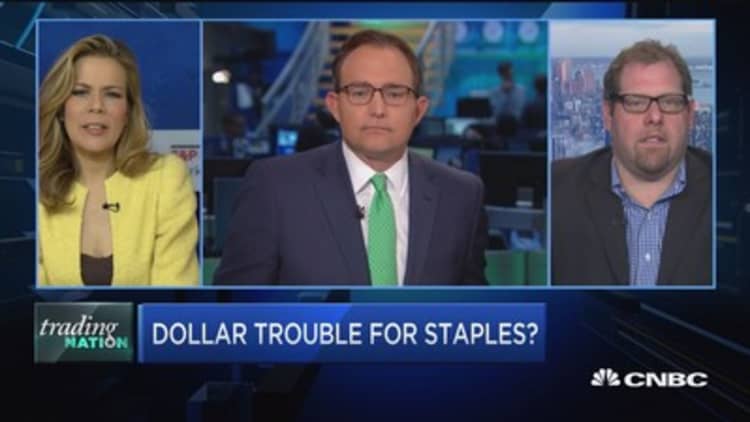
If the dollar keeps rising, investors may want to rethink consumer staples holdings in their portfolios.
The sector will face multiple headwinds in 2017 and see further downside, Goldman Sachs said Monday in a report that lowered its guidance for the group to cautious from neutral.
Multinational companies feeling the effects of a stronger U.S. dollar, rising interest rates negatively impacting companies' valuations and "relatively less (if any) benefits" from impending changes in tax policy were cited as challenges ahead for consumer staples.
The firm downgraded staples brands Coca-Cola and Procter & Gamble from neutral to sell ratings in two reports Monday, and shares of both fell about 1 percent during the trading session. A stronger U.S. dollar was a principal concern in its downgrade of Coca-Cola. For Procter & Gamble, its price-to-earnings ratio of 21.6 times earnings was deemed too rich. A strengthening U.S. dollar means that sales in foreign currencies translates into less domestic revenue.
Coca-Cola has seen the threat before. In its 2014 third-quarter earnings report, in which its revenue fell short of analysts' expectations, the company blamed currency-related headwinds against a stronger dollar.
However, as the U.S. dollar index has rallied to 14-year highs since the presidential election, some strategists say these are not reasons to sell the names.
"We still like several Consumer Staples companies, including KO [Coca-Cola] and PG [Procter & Gamble]. Consumer staples stocks actually have a slightly less foreign revenues than the broader S&P 500 index, with a little more [than] 35% of sales coming from outside the US," Erin Gibbs, equity chief investment officer at S&P Global, wrote Monday in an e-mail to CNBC, adding that she prefers Coca-Cola over Procter & Gamble.
In other words, a little over one-third of the sector's revenue comes in non-U.S. dollars, and thus consumer staples do not face as large a headwind as anticipated, according to Gibbs. And while investors' preference for growth in a "risk-on" environment may pose uncertainty for consumer staples, the space is expecting moderate 6.3 percent earnings per share growth this year, which may look attractive to investors, Gibbs wrote.
She prefers Coca-Cola over Procter & Gamble on a valuation basis. She said consumer staples could also benefit from lower corporate tax rates that President-elect Trump has proposed.
Consumer staples — conventionally a defensive sector given the broad nature of frequently used household names in the space — is the second-worst performing sector in the (after health care) over the last year, up about 5.5 percent in that time. The Consumer Staples Select Sector SPDR Fund ETF (XLP) is up about the same amount in the last year; Procter & Gamble and Coca-Cola, respectively, are the fund's top-weighted holdings, followed by tobacco manufacturers Philip Morris and Altria.
Max Wolff, market strategist at 55 Capital, sees concerns about a stronger U.S. dollar as overblown, although foreign exchange and heightened global trade volatility this year will still be a challenge for consumer staples.





